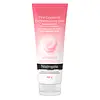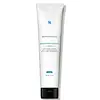What's inside
What's inside
 Key Ingredients
Key Ingredients

No key ingredients
 Benefits
Benefits

 Concerns
Concerns

 Ingredients Side-by-side
Ingredients Side-by-side

Water
Skin ConditioningGlycerin
HumectantMyristic Acid
CleansingStearic Acid
CleansingPotassium Hydroxide
BufferingLauric Acid
CleansingPalmitic Acid
EmollientPEG-32
HumectantCocamidopropyl Betaine
CleansingSodium Cocoyl Glycinate
CleansingPEG-100 Stearate
Glyceryl Stearate
EmollientPhenoxyethanol
PreservativePEG-75
HumectantSodium Chloride
MaskingPEG-150 Distearate
EmulsifyingPolyquaternium-7
Parfum
MaskingEthylhexylglycerin
Skin ConditioningDisodium EDTA
Propylene Glycol
HumectantCitrus Grandis Fruit Extract
AstringentCapric Acid
CleansingHydrolyzed Hyaluronic Acid
HumectantCitric Acid
BufferingGlycolic Acid
BufferingIron Oxides
Water, Glycerin, Myristic Acid, Stearic Acid, Potassium Hydroxide, Lauric Acid, Palmitic Acid, PEG-32, Cocamidopropyl Betaine, Sodium Cocoyl Glycinate, PEG-100 Stearate, Glyceryl Stearate, Phenoxyethanol, PEG-75, Sodium Chloride, PEG-150 Distearate, Polyquaternium-7, Parfum, Ethylhexylglycerin, Disodium EDTA, Propylene Glycol, Citrus Grandis Fruit Extract, Capric Acid, Hydrolyzed Hyaluronic Acid, Citric Acid, Glycolic Acid, Iron Oxides
Water
Skin ConditioningGlycerin
HumectantMyristic Acid
CleansingStearic Acid
CleansingSodium Cocoyl Glycinate
CleansingPalmitic Acid
EmollientLauric Acid
CleansingPotassium Hydroxide
BufferingSorbitan Palmitate
EmulsifyingPanthenol
Skin ConditioningPhenoxyethanol
PreservativeDisodium EDTA
Lavandula Angustifolia Oil
MaskingPolyquaternium-39
Citrus Aurantium Dulcis Oil
MaskingLimonene
PerfumingPelargonium Graveolens Flower Oil
Masking2-Oleamido-1,3-Octadecanediol
Skin ConditioningRosmarinus Officinalis Leaf Oil
MaskingLinalool
PerfumingCitronellol
PerfumingGeraniol
PerfumingSodium Benzoate
MaskingWater, Glycerin, Myristic Acid, Stearic Acid, Sodium Cocoyl Glycinate, Palmitic Acid, Lauric Acid, Potassium Hydroxide, Sorbitan Palmitate, Panthenol, Phenoxyethanol, Disodium EDTA, Lavandula Angustifolia Oil, Polyquaternium-39, Citrus Aurantium Dulcis Oil, Limonene, Pelargonium Graveolens Flower Oil, 2-Oleamido-1,3-Octadecanediol, Rosmarinus Officinalis Leaf Oil, Linalool, Citronellol, Geraniol, Sodium Benzoate
Ingredients Explained
These ingredients are found in both products.
Ingredients higher up in an ingredient list are typically present in a larger amount.
Disodium EDTA plays a role in making products more stable by aiding other preservatives.
It is a chelating agent, meaning it neutralizes metal ions that may be found in a product.
Disodium EDTA is a salt of edetic acid and is found to be safe in cosmetic ingredients.
Learn more about Disodium EDTAGlycerin is already naturally found in your skin. It helps moisturize and protect your skin.
A study from 2016 found glycerin to be more effective as a humectant than AHAs and hyaluronic acid.
As a humectant, it helps the skin stay hydrated by pulling moisture to your skin. The low molecular weight of glycerin allows it to pull moisture into the deeper layers of your skin.
Hydrated skin improves your skin barrier; Your skin barrier helps protect against irritants and bacteria.
Glycerin has also been found to have antimicrobial and antiviral properties. Due to these properties, glycerin is often used in wound and burn treatments.
In cosmetics, glycerin is usually derived from plants such as soybean or palm. However, it can also be sourced from animals, such as tallow or animal fat.
This ingredient is organic, colorless, odorless, and non-toxic.
Glycerin is the name for this ingredient in American English. British English uses Glycerol/Glycerine.
Learn more about GlycerinLauric Acid is a fatty acid or lipid. About half of fatty acids in coconut oil is lauric acid.
This ingredient helps hydrate and sooth skin. As a humectant, it helps trap moisture. It also aids in cleaning and enhancing the texture of products.
Lauric acid may not be Malassezia folliculitis, or fungal acne, safe.
Learn more about Lauric AcidMyristic Acid is a saturated fatty acid. It is naturally found in milk fat. Other sources include palm oil, coconut oil, and butter fat.
Myristic Acid is an emulsifer and cleanser. As an emulsifer, it stabilizes a product by preventing ingredients from separating. Myristic Acid helps clean your skin by acting as a surfactant. It tends to gather oil and dirt on your skin to be easily rinsed away.
One study from 2021 found Myristic Acid to have anti-inflammatory properties.
Learn more about Myristic AcidPalmitic Acid is a fatty acid naturally found in our skin and in many plant and animal sources. In cosmetics, it is usually derived from palm oil. It serves many purposes in skincare, acting as a cleanser, emollient, and emulsifier.
As an emollient, palmitic acid helps soften and smooth the skin by preventing water loss. In cleansers, it helps remove oil and dirt while creating foam.
Its emulsifying properties help stabilize products by keeping water and oil-based ingredients from separating.
This may not be suitable for fungal acne-prone skin, as fatty acids like this can sometimes trigger breakouts in sensitive individuals.
Learn more about Palmitic AcidPhenoxyethanol is a preservative that has germicide, antimicrobial, and aromatic properties. Studies show that phenoxyethanol can prevent microbial growth. By itself, it has a scent that is similar to that of a rose.
It's often used in formulations along with Caprylyl Glycol to preserve the shelf life of products.
Potassium hydroxide is commonly known as caustic potash. It is used to fix the pH of a product or as a cleaning agent in soap. In cleansers, it is used for the saponification of oils.
Sapnification is the process of creating fatty acid metal salts from triglycerides and a strong base. During this process, Potassium Hydroxide is used up and is not present in the final product.
Using high concentrations of Potassium Hydroxide have shown to irritate the skin.
Learn more about Potassium HydroxideSodium Cocoyl Glycinate is a cleansing agent. It can be naturally derived or synthetically-created.
As a surfactant, it helps clean your skin by gathering dirt, oil, and other pollutants to be rinsed away more easily.
Stearic Acid is a fatty acid. It is an emollient, emulsifier, and texture enhancer.
As an emollient, stearic acid helps soften skin. It aids the skin's protective barrier by preventing water loss. It also provides a gentle cleansing effect without stripping away natural oils.
Stearic acid may also be used to enhance the texture of products. It can add volume and stabilize ingredients such as water and oil. This can help water and oil ingredients from separating.
Sources of stearic acid include animal or vegetable fats/oils such as coconut or shea. It can be naturally found in butter, cocoa butter, shea butter, vegetable fats, and animal tallow.
This ingredient may not be Malassezia folliculitis, or fungal-acne safe.
Learn more about Stearic AcidWater. It's the most common cosmetic ingredient of all. You'll usually see it at the top of ingredient lists, meaning that it makes up the largest part of the product.
So why is it so popular? Water most often acts as a solvent - this means that it helps dissolve other ingredients into the formulation.
You'll also recognize water as that liquid we all need to stay alive. If you see this, drink a glass of water. Stay hydrated!
Learn more about Water